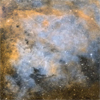CXC Home | Search | Help | Image Use Policy | Latest Images | Privacy | Accessibility | Glossary | Q&A
Multiwavelength W28
Quicktime MPEG
This video shows a classic example of a mixed-morphology supernova remnant known as W28. Each wavelength shows detailed structure of how the supernova shock wave is interacting, or has interacted, with the complex cloudy environment which surrounded its parent star. The stars and fine structure in the background are seen in optical light (grey and white) by the Cerro Tololo Inter-American Observatory in Chile. The radio (orange) data were obtained by the Very Large Array in New Mexico, while the blue in the wide-field view comes from the ROSAT satellite (X-rays). Data from NASA’s Chandra X-ray Observatory give new detail into the heart of W28 as seen in the final frame. In this close-up view of the center, low-energy X-rays are colored red, the medium are green, and the highest found by Chandra are blue.
[Runtime: 00:12]
Quicktime MPEG
This video shows a classic example of a mixed-morphology supernova remnant known as W28. Each wavelength shows detailed structure of how the supernova shock wave is interacting, or has interacted, with the complex cloudy environment which surrounded its parent star. The stars and fine structure in the background are seen in optical light (grey and white) by the Cerro Tololo Inter-American Observatory in Chile. The radio (orange) data were obtained by the Very Large Array in New Mexico, while the blue in the wide-field view comes from the ROSAT satellite (X-rays). Data from NASA’s Chandra X-ray Observatory give new detail into the heart of W28 as seen in the final frame. In this close-up view of the center, low-energy X-rays are colored red, the medium are green, and the highest found by Chandra are blue.
[Runtime: 00:12]
(Credit: Chandra X-ray: NASA/CXC/HSC/J. Keohane et al.; ROSAT X-ray: NASA/ROSAT; Optical: NOAO/CTIO/P.F. Winkler et al.; Radio: NSF/NRAO/VLA/G. Dubner et al.)
Return to W28 (June 2, 2008)



